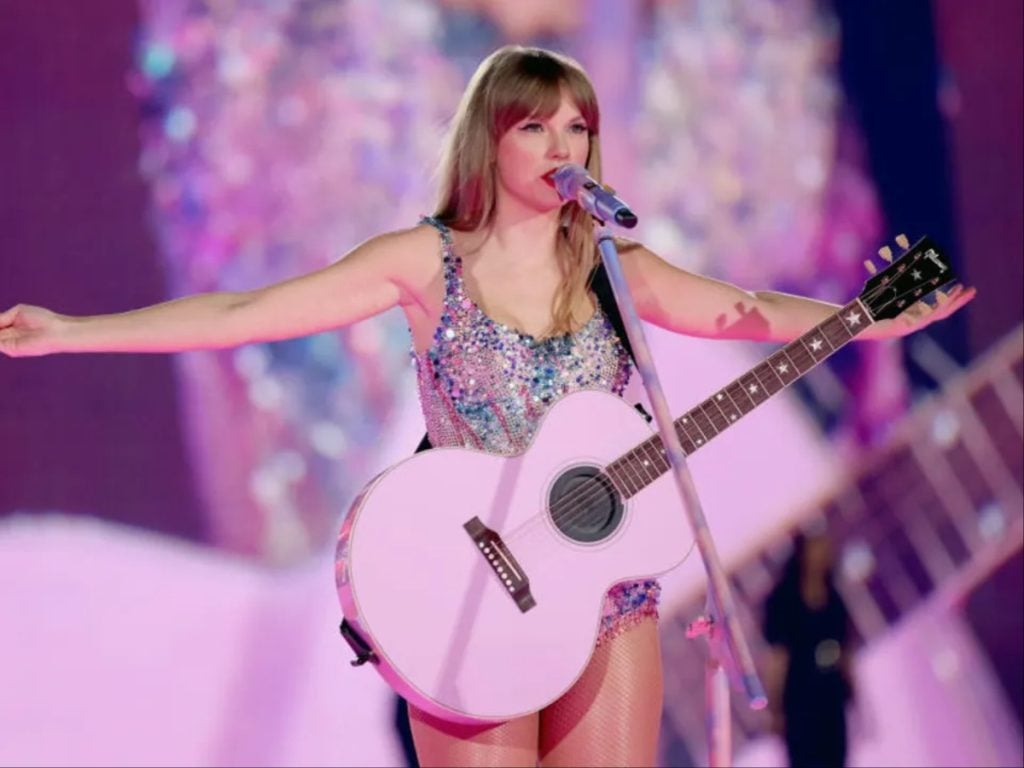Taylor Swift's Electrifying Seattle Concert Generates Actual Seismic Activity
The Swifties recently made international news after their energetic dancing and raucous cheering during the "Eras" tour concert in Seattle caused something bigger. Taylor Swift's electrifying Seattle concert generates actual seismic activity.
Author:Morgan MaverickReviewer:Professor JhizAug 01, 20235.5K Shares251.5K Views

The Swifties recently made international newsafter their energetic dancing and raucous cheering during the "Eras" tour concert in Seattle caused something bigger. Taylor Swift's electrifying Seattle concert generates actual seismic activity.
The pop superstar's dynamic performance, combined with the passionate energy of her fans, created vibrations that were so intense they were detected as seismic waves. The unexpected connection between live musicand geological phenomena showcases the power of music to move not only hearts but the very ground beneath our feet.
In this article, we will delve into the details of this remarkable event and the scientific implications of Taylor Swift's seismic concert.
The Concert That Shook The Earth
On a memorable nightin Seattle, Taylor Swift took the stage to perform before a massive crowd of adoring fans. The atmosphere was charged with excitement as the Grammy-winning artist sang her hits, and the audience sang along with fervor.
Little did they know that their enthusiasm would extend beyond the stadium's walls, making headlines for a seismic phenomenon.Taylor Swift's electrifying Seattle concert generates actual seismic activity.
Seismologists were astounded when they noticed the ground shaking during the concert. The vibrations were significant enough to register as seismic activity on monitoring equipment, typically used to detect earthquakes and other geological movements. The concert-generated seismic waves were a testament to the sheer force of Taylor Swift's music and the sheer passion of her devoted fan base.
According to a seismologist, seismic activity caused by Taylor Swift's concerts in Seattle, Washington, was on par with a 2.3 magnitude earthquake. On July 22 and 23, Swift's sold-out Eras tour performances at Lumen Field were where the data was collected.
According to seismologist Jackie Caplan-Auerbach, Swift's followers or the sound system were to blame for the activity. The performances surpassed Seattle's previous record, which was set during the "Beast Quake" of 2011.
Fans of American football who were ecstatic about Marshawn Lynch's touchdown for the Seattle Seahawks versus the New Orleans Saints caused that. The difference between the NFL game and Swift's most recent concerts was just 0.3, according to Dr. Caplan-Auerbach, a geology professor at Western Washington University, but the "shaking was twice as strong" and "absolutely doubled it."
She stated:
“„I grabbed the data from both nights of the concert and quickly noticed they were clearly the same pattern of signals. If I overlay them on top of each other, they're nearly identical.- Dr. Caplan-Auerbach
Over the course of two nights, the Seattle concerts were attended by 144,000 people in total.
Swift's Seattle performances were at the end of the Eras tour's US leg, which was her first tour in five years. Seismic activity has already been linked to musical performances, such as the 2011 Foo Fighters concert in New Zealand.
Understanding Seismic Activity At Concerts
Seismic activity at concerts is not an entirely novel occurrence. Vibrations from enthusiastic audiences dancing and stomping their feet have been recorded during various live events, particularly at large venues. However, the magnitude of the seismic waves generated during Taylor Swift's concert in Seattle stood out as a notable instance of music's impact on the Earth's surface.
During live music performances, especially high-energy shows like Taylor Swift's, large groups of people coming together create an immense release of kinetic energy. This energy gets transmitted through the ground as vibrations, and when the intensity is significant enough, it can be detected and recorded as seismic activity.
Scientific Implications
The seismic activity triggered by Taylor Swift's concert in Seattle has drawn the attention of scientists and researchers, prompting discussions about the potential applications of such observations.
Seismologists and geologists are interested in understanding how human activities, including large gatherings and events, can generate seismic waves and how these waves can be distinguished from natural geological events.
Beyond the scientific curiosity, there are practical applications of this phenomenon. Monitoring seismic activity during large concerts or gatherings could provide valuable data for crowd safety and event planning. Understanding the impact of human activities on the Earth's surface can aid in designing more resilient structures and infrastructure in densely populated areas.
Taylor Swift's Influence On Her Fans
The seismic concert in Seattle not only showcased the profound impact of Taylor Swift's music but also demonstrated the deep connection she shares with her fans. Swift's ability to create an electrifying atmosphere and engage her audience through her songs has earned her a devoted following worldwide. The seismic activity generated during her concert is a testament to the emotional and physical energy her performances elicit from her fans.
Taylor Swift's Response
Taylor Swift herself was taken aback by the news of the seismic activity during her concert. In a tweet following the event, she expressed her astonishment and gratitude to her fans, jokingly referring to the phenomenon as "shaking it off - literally."
The singer-songwriter's humility and sense of humor in the face of such an extraordinary event endeared her even further to her admirers.
In an Instagram post, Taylor Swift wrote:
“„Seattle that was genuinely one of my favourite weekends ever. Thank you for everything. All the cheering, screaming, jumping, dancing, singing at the top of your lungs.- Taylor Swift
Impact Of Music On Seismic Waves
Music has the remarkable power to evoke emotions, inspire creativity, and bring people together in shared experiences. But can music's impact transcend beyond the realm of human perception and touch the very Earth beneath our feet?
The intriguing concept of music affecting seismic waves has been a subject of scientific curiosity and exploration. In this article, we will delve into the fascinating world of music and its potential effects on seismic activity, exploring the scientific evidence and theories surrounding this captivating phenomenon.
Sound Waves And Seismic Waves
To understand the impact of music on seismic waves, it is essential to grasp the concept of sound waves and seismic waves. Sound waves are vibrations that travel through the air, water, or solid materials and are responsible for the auditory sensations we experience when listening to music.
Seismic waves, on the other hand, are vibrations that propagate through the Earth's crust and interior during geological events such as earthquakes and volcanic eruptions.
Seismology And The Study Of Seismic Waves
Seismology is the branch of geophysics dedicated to studying seismic waves and understanding the Earth's structure and processes. Seismologists use specialized instruments called seismometers to detect and measure seismic waves. These instruments can record the amplitude, frequency, and duration of seismic waves, providing valuable insights into the Earth's composition and behavior.
Theories On Music's Impact On Seismic Waves
The notion of music affecting seismic waves has sparked several theories and experiments. One prominent theory suggests that the intense and synchronized vibrations produced by powerful musical performances or large gatherings can, in theory, transmit energy into the Earth's crust. This energy, though minuscule in comparison to natural seismic events, has led to discussions about its potential effects on seismic monitoring equipment.
Concert-Generated Seismic Activity
There have been instances where large concerts or gatherings with fervent audiences have been associated with detectable seismic activity. The enthusiastic response of the crowd, such as jumping, dancing, or clapping, creates an immense release of kinetic energy that can travel through the ground. Seismometers positioned nearby have recorded these vibrations as seismic waves.
Taylor Swift's Seattle Concert And Seismic Activity
One prominent example of music's impact on seismic waves occurred during Taylor Swift's "Eras Tour" concert in Seattle. The electrifying performance and passionate energy of the audience generated seismic waves that were detected by monitoring equipment. The seismic activity from the concert made headlines and sparked discussions among scientists and music enthusiasts alike.
Scientific Implications And Applications
The observation of seismic activity generated by music has both scientific and practical implications. While the seismic waves produced by concerts are relatively minor and pose no threat, they provide a unique opportunity for researchers to study the interaction between human activities and the Earth's surface. Understanding how music can influence seismic waves may contribute to our knowledge of how energy propagates through the Earth.
Monitoring Public Events And Crowds
In addition to scientific curiosity, monitoring seismic activity during concerts and large public gatherings could have practical applications. Data from such observations could aid in crowd safety and event planning. Understanding the impact of human activities on seismic waves can also be valuable in designing resilient structures and infrastructure in densely populated areas.
Limitations And Ongoing Research
While the concept of music affecting seismic waves is intriguing, it is crucial to acknowledge the limitations of these phenomena. Concert-generated seismic activity is minor and not comparable to natural seismic events. Additionally, the study of music's impact on seismic waves is an evolving area of research, and more studies are needed to fully comprehend the underlying mechanisms.
People Also Ask
What Caused The Seismic Activity During Taylor Swift's Seattle Concert?
The seismic activity during Taylor Swift's Seattle concert was triggered by the combination of the artist's high-energy performance and the enthusiastic response from her passionate fan base. The release of kinetic energy from the large crowd's movements, such as dancing and stomping, generated vibrations that were recorded as seismic waves.
How Did Seismologists React To The Seismic Activity At The Concert?
Seismologists were astonished and intrigued by the seismic activity detected during Taylor Swift's concert. The unexpected connection between live music and geological phenomena sparked scientific discussions about the impact of human activities on the Earth's surface and the potential applications of such observations.
Are Seismic Waves Commonly Detected At Concerts?
While some level of seismic activity may be detected at concerts, particularly those with high-energy performances and large audiences, the magnitude of the seismic waves generated during Taylor Swift's Seattle concert was notable and drew significant attention from researchers and the public.
How Could Seismic Activity Monitoring During Concerts Be Useful?
Monitoring seismic activity during concerts and large gatherings could have practical applications for crowd safety and event planning. Understanding the impact of human activities on the Earth's surface can also aid in designing more resilient structures and infrastructure in densely populated areas.
How Did Taylor Swift React To The News Of The Seismic Activity At Her Concert?
Taylor Swift expressed her astonishment and gratitude to her fans in a tweet following the concert. She humorously referred to the phenomenon as "shaking it off - literally," showing her humility and sense of humor in the face of such an extraordinary event.
Conclusion
Taylor Swift's electrifying Seattle concert generates actual seismic activity. Taylor Swift's "Eras Tour" concert in Seattle will be remembered not only for its electrifying performance but also for the seismic waves it generated.
The fusion of music, energy, and emotion resulted in vibrations that shook the very ground beneath the stadium. This remarkable event serves as a reminder of the power of music to transcend boundaries, unite people, and even influence the natural world.
As scientists continue to study and understand the implications of this seismic phenomenon, Taylor Swift's seismic concert will undoubtedly remain an unforgettable moment in both music and scientific history.

Morgan Maverick
Author
Morgan Maverick is an unorthodox news reporter driven by an insatiable hunger for the truth. Fearless and unconventional, he uncovers hidden narratives that lie beneath the surface, transforming each news piece into a masterpiece of gritty authenticity. With a dedication that goes beyond the boundaries of conventional journalism, Morgan fearlessly explores the fringes of society, giving voice to the marginalized and shedding light on the darkest corners.
His raw and unfiltered reporting style challenges established norms, capturing the essence of humanity in its rawest form. Morgan Maverick stands as a beacon of truth, fearlessly pushing boundaries and inspiring others to question, dig deeper, and recognize the transformative power of journalism.

Professor Jhiz
Reviewer
Professor Jhiz brings fun to teaching anatomy. Born in China, she shares her fascination for how the body works.
Students say her lectures are lively with jokes and stories. She draws cartoon diagrams that highlight structures creatively.
Professor seeks to inspire curiosity and joy in anatomy. She treats each class like a show using props and costumes.
When not teaching, Jhiz enjoys karaoke and novelty socks. Her goal is passing on a spirit of wonder to students.
Latest Articles
Popular Articles


